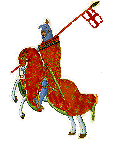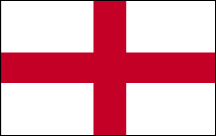 The life of Saint
George is shrouded in legend, so much so that it is quite difficult
to untangle fact from fiction. Much of the problem lies in the Acta
Sancti Georgii (Acts of Saint
George) written at a very early date and outlawed
by Pope Gelasius in AD 496. Meanwhile the Greeks also had a set of Acts
which were more accurate and quoted by Saint Andrew of Crete.
The life of Saint
George is shrouded in legend, so much so that it is quite difficult
to untangle fact from fiction. Much of the problem lies in the Acta
Sancti Georgii (Acts of Saint
George) written at a very early date and outlawed
by Pope Gelasius in AD 496. Meanwhile the Greeks also had a set of Acts
which were more accurate and quoted by Saint Andrew of Crete.
From them and the writings of
Metaphrastes, we can piece together that he was born in Cappadocia of
noble, Christian parents and on the death of his father, accompanied
his mother to Palestine, her country of origin, where she had land and
George was to run the estate. He was martyred at Lydda in Palestine
(Nicomedia). He held an important post in the Roman army - the rank
of tribune, or perhaps colonel in modern terms - during the reign of
the Emperor Dioclesian (245-313). Dioclesian was a great persecutor
of Christians (from about 302) and when the persecutions began George
put aside his office and complained personally to the Emperor of the
harshness of his decrees and the dreadful purges of Christians. For
his trouble, though, he was thrown into prison and tortured. He would
not recant his faith however and the following day he was dragged through
the streets and beheaded. It is uncertain whether he also tore down
the Emperor's decrees as they were posted in Nicomedia. So he was one
of the first to perish. The Emperor's wife, Alexandria was so impressed
at the Saint's courage that she became a Christian and so too was put
to death for her trouble.




![]() Patron
Saint Of England
Patron
Saint Of England![]()


![]()
![]()

![]()





